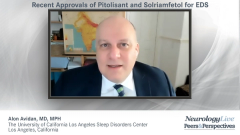
Pathophysiology and Risk Factors for Narcolepsy
Expert neurologists discuss the pathophysiology of narcolepsy and examine the role of genetic predisposition, environmental triggers, and immune system involvement.
Episodes in this series

Phyllis Zee, MD, PhD: When you think about sleep disorders, there has probably been 1 of the greatest discoveries, at least in my opinion: The pathophysiology or pathobiology of narcolepsy is a deficiency of orexin. These neurons have low levels of orexin, especially in people with type 1 narcolepsy.
What do know about the pathophysiology of narcolepsy and the orexin system, especially during the COVID-19 [coronavirus disease 2019] time? What is the role of autoimmune response? How do viruses or autoimmunity play a role in the pathobiology?
Alon Avidan, MD, MPH: The pathophysiology of type 1 narcolepsy, which is a narcolepsy with cataplexy or with a hypocretin deficiency, is somewhat more well delineated than the other phenotypes of central hypersomnia, such as narcolepsy type 2. Another form of daytime sleepiness is called idiopathic hypersomnia, where the pathophysiology is even less well elucidated. You are absolutely correct in that type 1 narcolepsy is fascinating. Throughout the last few years and decades, there have been more studies evaluating and demonstrating that, in dogs and in rats, there are certain specific genetic prerequisites that predict the onset of narcolepsy. In humans, it is fascinating that there has to be a genetic predisposition. The genetic predisposition for narcolepsy is conferred through the HLA gene, the DBQ10602, that confers a risk. The risk is conferred in the same fashion that 1 would have a risk for skin cancer if they had fair skin. The HLA titer is what confers the risk.
Not everyone with a positive or presence of this allele presents with narcolepsy. With the actual mechanisms of narcolepsy that occur for individuals who have the genetic predisposition, there has to be some sort of an insult, environmental or through inoculation. We learned that through the H1N1 pandemic a few years back, particularly in Scandinavia, where a live, attenuated vaccine was given to individuals against the H1N1 virus. That allele had action against the antibodies of the streptococcal antibody, and that was also destroying the hypocretin-producing cells in the hypothalamus. That was a window into the mechanism of narcolepsy in that there was some specific molecular mimicry where the streptococcal antibodies also destroyed the hypocretin-producing cells in the hypothalamus.
What is presumed to be the trigger in the rest of the world is not known. There must be an environmental trigger, and we often see patients presenting with severe symptoms of narcolepsy after the flu or after they were sick, so that is a good clue that they may have experienced the same mechanism of an autoimmune destruction of hypocretin.
Phyllis Zee, MD, PhD: The ongoing hypothesis is that it is an autoimmune disorder, and for some odd reason, it is likely targeting the set of hypocretin neurons or orexin neurons in the hypothalamus. That is interesting.
Thank you for watching this NeurologyLive® Peers & Perspectives® program. Please subscribe to the e-newsletter to receive upcoming Peer Exchanges® and other great content in your inbox.
Transcript Edited for Clarity
Newsletter
Keep your finger on the pulse of neurology—subscribe to NeurologyLive for expert interviews, new data, and breakthrough treatment updates.





































